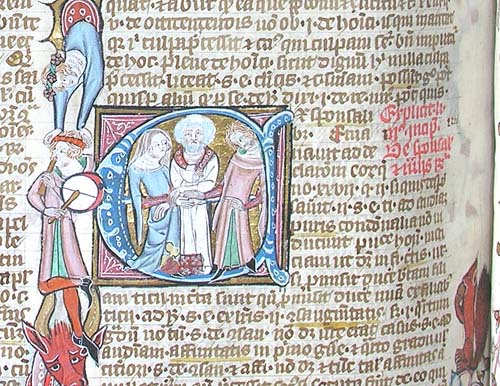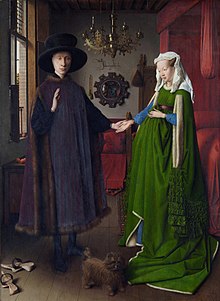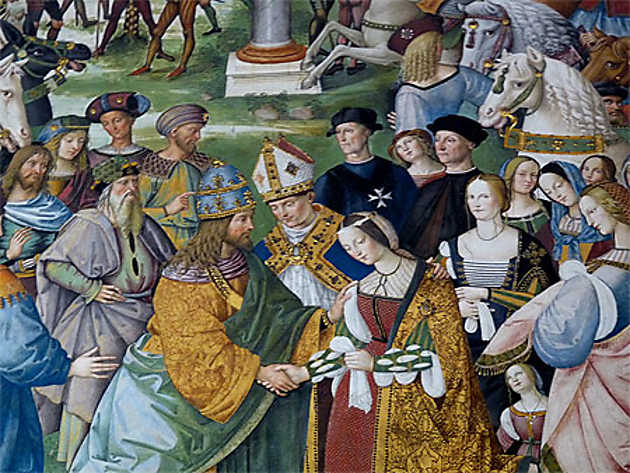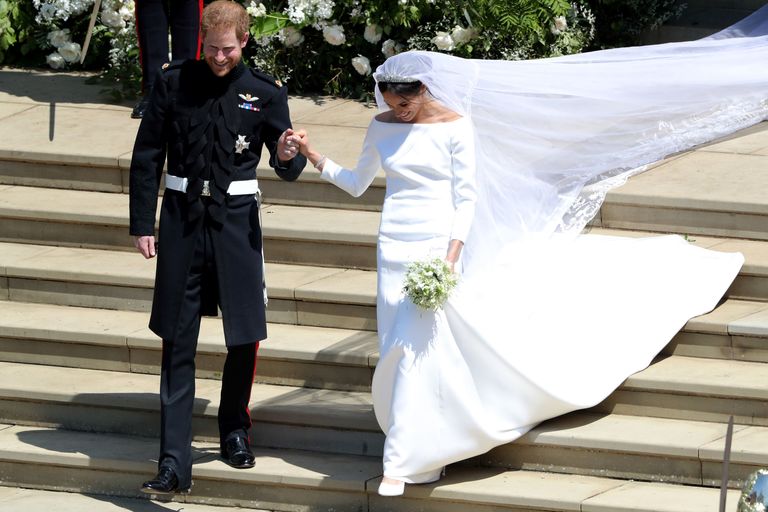Fashion Stories and the Story of the Wedding Dress - Visual Diary
- Cath @MyMarketingToolbox

- Feb 5, 2022
- 9 min read
What is considered as the most beautiful day in the life of a woman? For some, it’s her wedding. And the choice of the right wedding dress is paramount in the success of this special day.
But, when did we start wearing a special dress to celebrate a wedding?
Has the wedding dress always been white?
Are there any symbols linked with the wedding dress and the accessories we wear with it?
And why is the wedding dress considered as the show stopper of a Haute Couture fashion show?

From the Antiquity to modern times, let’s explore together wedding dress practices and its symbolism through colors, veils and bouquets.
Starting from young age, little girls start to plan their wedding, what kind of dress they would wear, how they would be the most beautiful bride ever, incidentally also picturing how their husband would be (rich, young and handsome thanks to the Disney fairytales…).
I also liked to look at my parents’ wedding pictures, marveling at my mother’s wedding dress and how beautiful she was. She kept the wedding dresses catalogs from when she was preparing her wedding and I liked to flip through the pages, looking at the various models and trying to choose which one I would have for my own wedding. And, at that time, I was quite disappointed by the choice my paternal grand-mother did for her own wedding: a minimalist skirt suit in dark grey with a white blouse and a beautiful hat. Though, being now older and a bit older than when she got married, I completely understand this choice of not having a “proper white” wedding dress. If I got married one day, it won’t be the same type of dress than the one I thought it would be when I was 12 years old.
Aside from these personal considerations, why do we wear white dresses for wedding? Why is it “proper” to have a white dress? And why having a special dress?
The evolution of wedding dress practices through the ages
Wedding dresses are, per se, not something new. From the beginning of time, to celebrate the union of two people, the groom and the bride would wear more beautiful outfits than the ones for their everyday life.
Antiquity
Throughout the Antiquity, the type of clothing worn by women to celebrate their union was following their daily outfits. In Ancient Egypt, women would wear their kalasiris with a wig and jewelry.

In Ancient Greece, they could wear two types of dress: the peplos, a large piece of rectangular fabrics wrapped around the body and fastened at the waist with a belt and at the shoulders’ level with pins, the fibulas. And the other type of dress was the chiton, which would work the same way as the peplos.
The belt used to fasten the peplos, or chiton, around the waist, the zone, would be fastened in different ways and would have different meanings when worn by women. Thus, the zone was an indicator of sexual maturity as this belt would be worn fastened only by menstruated women and the act of fastening the zone would show the readiness of the girl/woman to get married. Not yet menstruated women, young girls would wear the zone not fastened around the waist, hanging. Unmarried adult women, as a way to show their virginity, would wear it belted and, during the wedding night, the act of unbelting the zone by her husband would symbolize the accomplishment of the sexual intercourse, sealing the wedding.
Women would also wear a veil to complete their wedding outfit.

Ancient Roman women would also wear a dress, the tunica recta, a stola made of a long piece of rectangular fabrics up to the feet. At the waist, a belt was knotted with a special knot, the Hercules knot, symbolizing love and marriage, that only the groom, on the wedding night, could unknot. The head of the bride was covered by a veil, the flammeum, which could be yellow or orange, a yellow hairnet.
Their hairs would be separated by a spear, or hasta, which would symbolize the husband’s authority on his wife and a protection against a troubled marriage. The hairs would be breaded under the veil and flowers could be displayed on the veil, as crown of orange blossoms. They would wear saffron/orange colored sandals.
Ancient Romans would get married in June in preference, as it was the month of the goddess Juno, the equivalent of Hera in the Greek mythology, and the yellow hairnet was dedicated to the lares, the guardian deities in Ancient Rome.
The Middle Ages
During the Middle Ages, no specific dress was worn to celebrate the wedding. Women would wear their most beautiful dress and the color wasn’t that important. By looking at paintings of that time, we can have a more precise idea on how women were dressed for their special day.
Dresses could from different colors, like dark blue, shades of red made of velvet, satin, silk or brocade silk ornated with patterns embroidered in gold and white ermine furs for the wealthier. For poorer women, the fabrics of choice would be linen or cotton and they would wear their Sunday dress for their wedding, the dress they would wear only to go to the Church on Sundays, thus the best one they had.
On the top of a chemise and stockings, the medieval woman would wear a long dress made of a bodice and skirt. On the top of this dress, they could wear a second dress, the cotehardie, whose bodice was quite fitted to the body and which would become ampler from the tights and long until the ankles with a train. This is this dress which would be richly decorated to show the status of the family the woman was coming from. To go with their dress, women could wear a pointy headwear with a veil or a crown made of flowers.
The Renaissance
Starting from the Renaissance time, following the changes in the form of the dresses, the dress worn for the wedding would also evolve. The wealthier the family, the more richly decorated the dress would be.
In the countryside, local traditional costumes could be also worn for weddings, a practice which will last for several centuries.
As we could see, we didn’t have any fixed rules regarding wedding dresses, and in particular, their colors. The main word was “Wear your most beautiful dress for your wedding”. Bright colors, as red, would even been favored.
When the wedding dress started to be white
The first woman spotted to wear a white dress for her wedding was Mary Stuart, Queen of Scotland, when she married Francis the 2nd , King of France, in April 1558. Why white? Well there can be different explanations for this choice.
The first one was that white would have been the color of her mother’s family, Mary of Guise, and she might have wanted to pay tribute to that side of her family during her wedding. The other explanation was that she chose this color to mourn her father, who died when she was 6 days old, and pay tribute to him during her wedding, white being the color of mourning at that time in European countries. Nobody is sure of why this choice of color but it inspired other women to choose this color for their wedding dress too for a while. It wouldn’t last long though, as, after some times, women would opt back for colored dresses for their wedding and, especially black, or dark colors, for countryside and peasant families as these were colors and dresses which could be worn several times after the wedding, and not just for the wedding itself.

We would need to wait for another queen’s wedding to have white being imposed as the color of choice for wedding dress. And this queen is Queen Victoria, the ancestor of Queen Elisabeth the 2nd.
We can ask ourselves the same question as above: why white?
Queen Victoria got married to Prince Albert in 1840. The dress and other accessories she would wear would heavily influence the fashion for wedding dresses, including the form of the dress and its color, white. White would have been chosen for 2 reasons it seems.
The first one being that Queen Victoria didn’t want to outshine her fiance’s outfit which was in deep and bright reds. So she decided to down tune the color of her own outfit and chose white. It is said that Queen Victoria was deeply in love with her husband, which could explain why, even if she was a queen, she decided to be less visible than him on that important day.
The other reason was that this choice of color, as well as the choice of fabrics, would help to relaunch the industry of satin and of Honiton lace, thus helping the economic growth of the London suburbs of Spitalfields.
When love and economy meet…
Starting from there, white will be adopted as the official color for wedding dress and the Christian religion will even add another symbolic to this color. Not only white would be associated with wealth, and not every woman would be able to afford a white dress for their wedding, but white would also represent virginity, purity and innocence, concepts so dear to the Church and to the society starting from the 19th century when it came to the perception of women inside the society.
Then, another reason will make white assessing its status of monopole of colors for wedding dresses: the invention of the photography. Remember, at that time, photos were more in black and white or sepia tones. Of course, a white dress would pop up more brightly than a colored one which could be lost among the other darker colors of the picture.
Symbolism in the wedding outfit for women
The white wedding dress became a classics and almost mandatory. It was a way to show the purity and innocence of the bride and only women who were married once could wear colored dresses for their second wedding.
We will need to wait for the 90s to have colors back in fashion for wedding wear.
Nowadays, wedding dresses are less regulated as it used to be in the past. You can basically wear whatever dress or other outfit in whatever colors you want. If 20 years ago when I was imagining my own wedding, I was thinking of a long lace and satin white dress with a train and a veil making me look like a princess, now, if one day I get married, which is not a priority neither, I’m more into having a simple pant suit in off-white colors, maybe a designer one, with a wide brimmed hat. Something I could wear for other occasions, something I could pass along.
Because, yes, wedding dresses started to be an investment, a dress you would wear only once in your lifetime. And, in some families, wedding dresses were passed along from generation of women to generation of women. Nowadays, you see more and more 2nd hand wedding dresses on the market, a translation of the air of our times maybe…
Traditionally, alongside with the wedding dress, the bride would wear a veil and have a bouquet of flowers.
The veil is an accessories that we saw starting from Ancient Greece which would come and go according to the fashion of the time, the traditions and habits. Depending on the century, you can see long veils covering the body, hiding it, shorter veils attached to other headpieces as hats, hairnets or just the hairs beautifully done and decorated with pearls, jewelry, flowers or flower crowns.
The tradition of having a bouquet of flowers for the wedding would go back to the Crusades when the knights were coming back from the Middle East with the practice of brides to do bouquets of orange blossoms, symbolizing purity, to announce their wedding.
Other sources date the wedding bouquet back to the Antiquity when brides would have a bouquet of aromatic plants to protect the newly weds from bad spirits. Some of the plants used might also have aphrodisiac powers…
But a more pragmatic reason for having a bouquet of flowers would have been that the smell of the flowers would hide the body smells... In the past, weddings were celebrated during Spring and Summer, people would get hot and bouquets were done with natural, seasonal flowers to help hiding these bad smells. Nowadays, bouquets can be done with natural or artificial flowers.
During the 19th century up to the beginning of the 20th century, the tradition was to keep the bride’s bouquet in a special recipient, a transparent glass recipient in the form of a bell with a velvet cushion to put the bouquet on it. The couple had to keep it during the length of their marriage. At my parents’ place, we have some of these beautiful recipients. My mother used one to put her own wedding flower crown.
Visual retrospective of wedding dresses
The form of the wedding dress itself would really follow the silhouette of the time: La Belle Epoque, the 20s, the 30s silhouettes would be reflected in the cut of the wedding dress. During the 2nd World War, because of fabrics shortage and rationing, women would choose shorter dresses, sometimes suits with shorter hemlines, that they could wear of other occasions. Influenced by Christian Dior’s New look and his voluminous skirts, the 50s will see ample and long wedding dresses, while the 60s, the era of the mini skirts by Mary Quant, will see wedding dresses with shorter hemlines.
So many traditions linked with the wedding outfits: the veil, the headpiece, the bouquet, the dress which, no matter the style, the colors, the fabrics, if it’s a unique dress specially of this day, or an outfit meant to be worn again, or a traditional local costume, this will be your most beautiful outfit which will make you the most beautiful bride.
That is maybe why the wedding dress is the show stopper of Haute Couture fashion shows. A dress so beautifully executed that it will make everybody dreaming of looking like a princess, at least for a day. By the way, did you know that the tradition to end a fashion show with a wedding dress was launched in the 50s by Christian Dior?
And, to conclude this article on wedding dresses, here is a selection from Spring/Summer 2022 wedding dresses by designers as Alexis Mabille, Antonio Grimaldi, Celia Kritharioti, Chanel, Christian Dior, Elie Saab, Fendi, Giambattista Valli, Jean-Paul Gaultier, Schiaparelli, Valentino, Viktor and Rolf and Zuhair Murad.
Enjoy :)
Which one do you prefer?
Feel free to follow the podcast My Fashion Stories Box on your favorite podcast platform, on Instagram and on the blog for a visual diary alongside with each episode.
See you there!
Cath @MyMarketingToolbox






















































































































































Comments